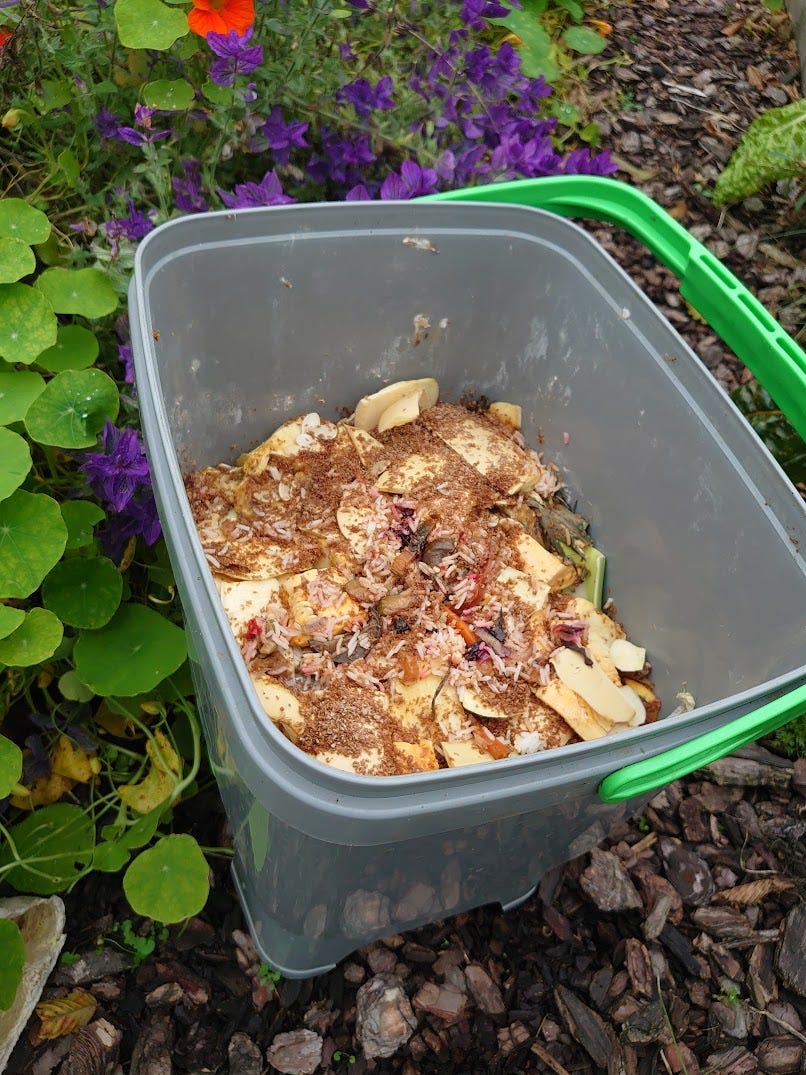How fermentation can boost soil health
Bokashi - how fermenting your kitchen waste can improve soil health, reduce your carbon footprint and help you to recycle more of your waste
🌱 I'm Sally Morgan, an organic gardener and botanist who loves to experiment. Here you can read about matters relating to climate change, sustainability, organic gardening and growing veg, helping you to become a climate savvy gardener 🌱☀️🌧️❄️🌡️
Resilience 5
Your monthly newsletter that digs deep into a particular topic (the full article is available to paid subscribers, but free subscribers can read much of it)
We hear a lot about fermented foods and how they can help our gut health. Once it was just yoghurt and sauerkraut, but nowadays, supermarket shelves have a huge range of fermented foods - kimchi, kombucha, kefir, miso, fish sauce, tempeh, ginger beer, salami, sourdough bread, and more
Fermented foods are packed with beneficial microbes that support gut health and balance the gut biome, aiding digestion and reducing bloating. boosting nutrient absorption and immunity, reducing inflammation and helping mental health.
So I doubt its a surprise to gardeners if I say that fermentation can boost soil health too.
What is bokashi?
I first came across bokashi around 20 years ago when I bought a bokashi bin and some inoculated bran. At the time, the guidance was rather unclear and full of what I now know to be wild claims. I mistakenly believed it would be able to compost all my kitchen waste, including meat, within a few weeks. Unsurprisingly, it didn’t, my enthusiasm waned, and then my experiment came to an abrupt end when one of my dogs, no doubt lured by the foodie smell, chewed the corner of the bin!
What that early promotional material failed to explain was that bokashi isn’t a method of composting. The word bokashi means " fermented organic matter", and the process relies on anaerobic fermentation to pickle organic waste rather than aerobic decomposition.
For years, my neglected bokashi bins gathered dust until I came across new research on bokashi and composting while editing Organic Farming magazine.
Unlike composting, which is a mostly aerobic process in which microorganisms break down organic matter in the presence of oxygen, fermentation is anaerobic. The microbes in bokashi loosen and break down cell structures, sort of pre-digesting the waste. This prepares the material for composting, allowing it to decompose much faster once added to a compost bin or soil.
This fermentation method was devised by Prof Teruo Higa at University of Ryukyus in Japan in 1982. It was pure luck that he stumbled across a combination of microbes that promoted plant health. Further studies led to the creation of the optimal mix which he called Effective Microorganisms or EMs.
Fermenting my food waste
EMs are a mix of mostly anaerobic microbes that occur naturally in the soil and they improve soil quality, boost plant growth and help crop health. They work by competitive exclusion, which means they work together to suppress any harmful pathogens that might be present. Now, there are licensed producers around the world making the mix of fungi, yeast, lactic acid bacteria, phototropic bacteria and actinobacteria. There is plenty of information here
This is the bin I use to ferment my kitchen waste. I add layer of chopped up food waste, sprinkle with the inoculated bokashi bran and squish down to push out the air. I keep adding layers of food and bran until the container is full. This usually takes me a couple of weeks. Then I leave it in a cool place, with the lid sealed so it can continue to ferment for a few more weeks.
Often you see a white fungus growing across the surface of the food in the bin, which tells you that fermentation is in process. You don’t want the food to go brown or black, rot and become smelly.

The contents of the bokashi bin can be simply tipped into a compost bin but some people prefer to dig a trench to bury the waste and others add it to their wormery.
The fermentation produces quite a lot of liquid which collects in the bottom of the container. Analysis shows its mostly P and K, rather than N, with some micronutrients. It cannot be used in its raw form, unless added straight to compost heap. To use it as a plant feed, dilute it 1:30 with water.
Since you have to leave the bokashi in the bin for a couple of weeks, you need at least two if not more bins. I bought a standard bin but I have several others that we’ve made from airtight buckets with handles. You can either use a pair of buckets, piercing holes in the bottom of one and popping it inside the first bucket, or simply don’t bother collecting the liquid and have a thick layer of cardboard at the bottom of the bucket to soak up the liquid – then it all goes in the compost bin.
One of the key things about bokashi is there is no smell of rotting food, just a sweet, slightly pickled smell. Its ideal for people living in apartments as the food waste does not have to be taken out every day. The other benefit is that it does not attract vermin when tipped in the compost.
How does bokashi help climate change?







